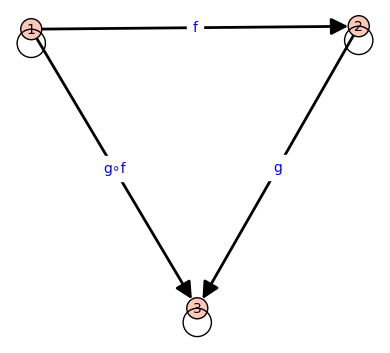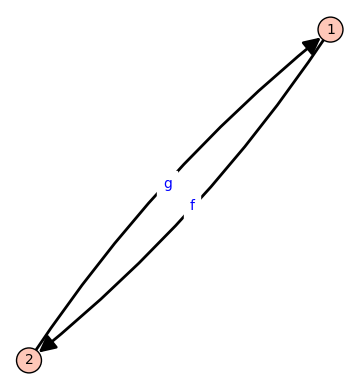6. Real World Math#
6.1. Functional Programming#
6.1.1. DE & Programming#
Functors can be viewed as structures that map functions to their derivatives while preserving mathematical relationships.
Mathematical Functor: Differentiation Operator A function \(f(x)\) maps to its derivative \(f'(x)\)
Higher-Order Functors: in more advanced settings, applicative functors and monads can model systems of differential equations by composing multiple functors.
Concept |
Mathematics |
Haskell Functor Example |
|---|---|---|
Differentiation |
\(f(x)\) → \(f'(x)\) |
Stream-based Taylor series functor |
Taylor Series |
Recursive differential expansion |
Infinite stream functor |
Differential Operator |
Higher-order mappings |
Functor for applying derivatives |
Numerical Methods |
Euler’s method |
Recursive functor iteration |
Coupled Systems |
Systems of differential equations |
Functor composition |
6.1.2. Category Theory & Programming#
Category Theory |
Graph Theory |
Differential Equations |
Functional Programming |
Linguistics |
|---|---|---|---|---|
Objects (Types, Structures): Abstract entities in a category. |
Nodes (Vertices): Fundamental units in a graph. |
State Variables: x,y,t represent system states. |
Data Types, Values: Represented as immutable structures. |
Words, Morphemes, Syntactic Categories: Fundamental linguistic units. |
Morphisms (Arrows): Structure-preserving maps between objects. |
Edges (Connections): Relationships between nodes. |
Derivatives \(\frac{dx}{dt}\): Rate of change between states. |
Functions (Mappings): Transform input values into output values. |
Grammar Rules, Transformations: Define linguistic relationships. |
Composition f∘g: Associativity of mappings. |
Path Composition: Combining edges to form paths. |
Successive Differentiation \(\frac{d}{dt} (f∘g)\) |
Function Composition f . g: Chain transformations. |
Syntactic/Semantic Composition: Meaning built from smaller parts. |
Identity Morphism \(idA\):A→A: Acts as a neutral element. |
Self-loops (Trivial Paths): Node connected to itself. |
Equilibrium State: \(\frac{dx}{dt} = 0\) (no change). |
Identity Function id x = x: Leaves values unchanged. |
Base Forms, Root Morphemes: Core linguistic elements. |
Associativity: h∘(g∘f)=(h∘g)∘f |
Associativity of Paths: Order of traversal doesn’t change results. |
Chain Rule: \(\frac{d}{dt} (f∘g)=f'⋅g'\). |
Associative Function Composition: (f . g) . h = f . (g . h). |
Phrase Structure Rules: Hierarchical syntax follows associative principles. |
Functors: Map one category to another while preserving structure. |
Graph Homomorphisms: Preserve relationships between graphs. |
Transformations (Laplace, Fourier): Convert functions to new domains. |
Higher-Order Functions (map, fmap): Apply transformations generically. |
Grammatical Mappings: Transform structures while maintaining meaning. |
Monoids: Categories with one object (single composition rule). |
Concatenation of Walks: Paths in a graph form a monoid. |
Differential Operators \(D=\frac{d}{dx}\): Form algebraic monoids. |
Monoids in Functional Programming: Structures like fold, concat. |
Agglutinative Morphologies: Word formation by concatenation. |
Monads: Endofunctors with structure to model computation. |
Graph Traversals with Constraints: Restricted pathfinding. |
Iterative Solutions & Integration: Successive differentiation/integration. |
Monads (Maybe, IO): Structure computations with effects. |
Sequential Parsing: Building meaning through ordered language structures. |
Natural Transformations: Transformations between functors. |
Graph Transformations: Convert graphs into equivalent forms. |
Change of Variables: Transform differential equations into simpler forms. |
Mapping Between Functors (fmap): Applies functions over wrapped data. |
Morphological Derivations: Word transformations (e.g., verb → noun). |
Initial/Terminal Objects: Least/greatest elements in a category. |
Source/Sink Nodes: Starting or ending points in a graph. |
Steady-State Solutions: Fixed points in differential equations. |
Empty Lists ([]), Unit Type (): Base cases for recursive structures. |
Base Words vs. Derived Words: Root lexemes vs. inflected forms. |
Limits/Colimits: Universal constructions in category theory. |
Minimum Spanning Trees, Flows: Graph optimization structures. |
Fixed Points of DE: Equilibrium solutions. |
Recursive Data Types: Structures defined in terms of themselves. |
Common Structures in Syntax Trees: Shared hierarchical patterns. |
Fixed Points: F(X)≅X , objects that remain unchanged. |
Graph Cycles, Steady States: Fixed structures in graph transformations. |
Equilibrium Solutions: Where \(\frac{dx}{dt} = 0\). |
Recursion (fix f = f (fix f)): Self-referential function calls. |
Stable Forms in Language: Syntactic patterns that remain unchanged over transformations. |
Adjunctions: Relationship between functors, bridging categories. |
Network Flow Optimizations: Graph constraints and adjunction-like structures. |
Adjoint Operators in DE: Pairing transformations. |
Free and Cofree Monads: Duality in computational structures. |
Grammar Constraints & Transformations: Relations between linguistic components. |
Isomorphisms: Bijective morphisms between objects. |
Graph Isomorphisms: Structural equivalence of graphs. |
Transformation Preserving Solutions: Linearization techniques. |
Type Equivalences (newtype, Iso): Structurally identical data representations. |
Synonymy & Paraphrasing: Different expressions preserving meaning. |
Categories as Structures: Model mathematical and logical structures. |
Graphs as Networks: Abstract representations of relationships. |
Systems of DE: Structured dynamic models. |
Programs as Expressions: Functional structure in computations. |
Languages as Hierarchical Systems: Syntax and semantics with nested structures. |
Category Theory |
VS. Type theory |
|---|---|
- formalism abstraction, package “entire theory” |
- One is Lambda Calculus(untyped), e.g. python-lambda-calculus |
A way of representing things and ways to go between things. A Category \(C\) is defined by:
Objects \(ob(C)\) & Morphisms \(hom(C)\)
Composition law (∘) & Associativity: h∘(g∘f)=(h∘g)∘f
Mathematician |
Programmer(Graph or Discrete) |
|---|---|
Object |
Type, Node |
Morphism |
Function, Arrow, directed-edges |
Functor |
polymorphic type |
Monoid |
String-like |
Preorder |
Acyclic graph |
Isomorph |
The same |
Natural transformation |
rearrangement function |
# A Simple Category: with composition and identity morphisms
G = DiGraph( {1 : [1], 2 : [2], 3 : [3]})
G.add_edges([(1, 2, "f"), (2, 3, "g"), (1, 3, "g∘f") ])
G.show(edge_labels=True)

# This graph is not a category because there is no explicit composition
G = DiGraph()
G.add_edges([(1, 2, "f"), (2, 3, "g")]) # Missing (1, 3, "g∘f")
G.show(edge_labels=True)

# This graph is not a category because it lacks identity morphisms
G = DiGraph()
G.add_edges([(1, 2, "f"), (2, 1, "g")]) # No identity morphisms
G.show(edge_labels=True)

Categories .VS. DAGs(Graph Theory)
Property |
DAG |
Category |
|---|---|---|
Directed edges |
✅ |
✅ |
No cycles |
✅ |
❌ Not always |
Self-loops allowed? |
❌ No |
✅ Yes (identity morphisms) |
Must have composable paths? |
❌ No |
✅ Yes |
If a category has no isomorphisms (self-loops) and only strictly hierarchical structure, it could be a DAG.
e.g. A preorder category, where there is at most one morphism between any two objects and no reversibility, can be represented as a DAG.
A poset category is always a DAG because it models partial ordering.
Functor: structure preserving mapping between categories (like rebuilding an organisation)
In Haskell, functor can be seen as boxes containing all types and functions. Haskell types look like a fractal(can replicate).

Category Theory oriented Programming:
Focus on the type and operators
Extreme generalisation and better modularity
6.1.3. FP Wolfram Language: from Functional Programming#
(*OOP*)
data={a,b,c};
Do[
data[[k]]=f[data[[k]]], {k,Length[data]}
];
data
(*FP*)
Map[f,{a,b,c}]
f /@ {a,b,c}
Map[f, {{1,2,3},{4,5,6},{7,8,9}}]
Map[f, {{1,2,3},{4,5,6},{7,8,9}}, {1}]
Map[f, {{1,2,3},{4,5,6},{7,8,9}}, {2}] (*{2} indicates level 2*)
Map[Reverse, {{1,2,3},{4,5,6},{7,8,9}}] (*With-In*)
Map[Reverse, {{1,2,3},{4,5,6},{7,8,9}}, {1}]
Reverse[{{1,2,3},{4,5,6},{7,8,9}}] (*Between*)
Map[Sort, {{2,1,3},{a,c,b},{7,2,8}}]
Sort[{{2,1,3},{a,c,b},{7,2,8}}]
Apply[g,f[1,2,3]]
g @@ f[1,2,3]
Apply[g, {{1,2,3},{4,5,6},{7,8,9}}, {1}]
Apply[Rule,{x,5}] (*a -> 1 is read as "a maps to 1"*)
Apply[Rule, {{a,1},{b,2},{c,3}}, {1}] (*turn pairs into a list of rules*)
Rule @@@ {{a,1},{b,2},{c,3}}
Nest[f,x,3]
NestList[f,x,3]
Nest[(1+r)# &, A, 5]
NestList[(1+r)# &, A, 5]
NestList[1.1#&, 100, 5]
FixedPoint[(#+2/#)/2 &, 1.0]
FixedPointList[(#+2/#)/2 &, 1.0]
ListPlot[FixedPointList[(# + 2/#)/2 &, 1.0],
PlotStyle -> {Blue, PointSize[Medium]},
GridLines -> Automatic,
AxesLabel -> {"Iteration", "Value"},
PlotRange -> All]
Fold[f,x,{a,b,c}]
FoldList[f,x,{a,b,c}]
FoldList[Max,{1,5,2,4,7,9,1,1}]
Map[(#+x)&,{1,2,3,4,5}]
{1,2,3,4,5}+x
Apply[Plus,{1,2,3,4,5}]
Total[{1,2,3,4,5}]
FoldList[Plus,{1,2,3,4,5}]
Accumulate[{1,2,3,4,5}]
Total[{{1,1,1},{2,2,2},{3,3,3}}]
Map[Select[#,EvenQ]& , {{1,2,3},{4,5,6},{7,8,9}}]
Map[Select[ EvenQ] , {{1,2,3},{4,5,6},{7,8,9}}]
f[p_]:=Select[p,EvenQ]
Map[f , {{1,2,3},{4,5,6},{7,8,9}}]
f = If[#==0 , 1 , # f[#-1]] &; (* #和f 中间空格表示乘号 *)
f[5] (* 5!=120 *)
120
Clear[f]
MapThread[f,{{a,b,c},{x,y,z}}]
BlockMap[f,{1,2,3,4,5,6,7,8,9}, 3]
BlockMap[f,{1,2,3,4,5,6,7,8,9}, 3,1]
ArrayFilter[f,{1,2,3,4,5,6,7,8,9}, 1, Padding->None]
ArrayFilter[Mean,{1,2,3,4,5,6,7,8,9}, 1, Padding->None]
6.2. Coding Theory & Information#
symbols<->info, data storage/compression/transmission/cryptography, error detection/correction to protect information
6.3. Data analysis#
Visualisation, Simulation
6.4. Statistics & Probability Theory(SPT)#
Descriptive, Inferential, Correlation & Regression, Sample Spaces (countable VS. uncountable), Conditional Probability, Random Variable
Math built SPT through two ways:
Discrete approach through combinatorics
Continuous approach through measure theory (e.g. modelling Stochastic Processes正态分布,是一种模型,对binomial分布进行模拟)
6.5. Game Theory & Decision & Operation#
Utilities/Strategies, Decision Analysis, Optimization, Stochastic Process Modeling
6.6. Quantum Theory#
This is cornerstone of modern physics, with deep roots in Linear Algebra, Functional Analysis, DE, Complex Analysis, Group Theory, Probability & Statistics, Topology, Measure and Variational Calculus